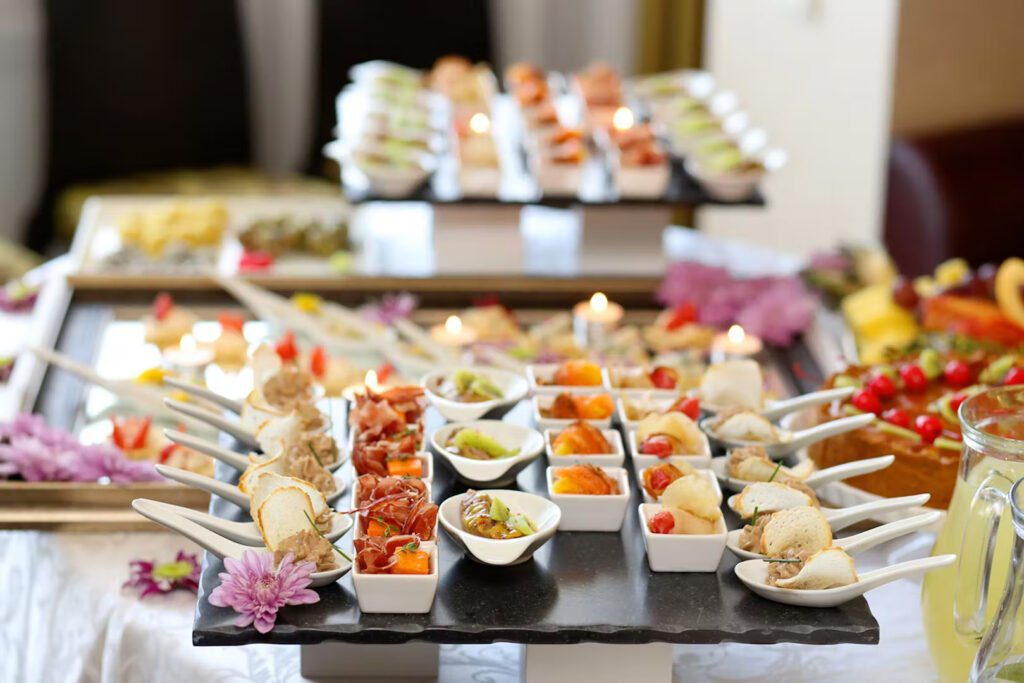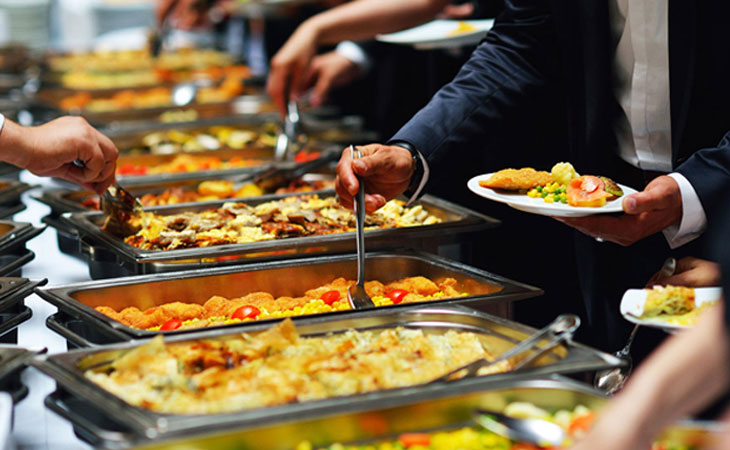Corporate catering lunches are a vital part of many businesses, providing a convenient way for employees to have a meal during the workday. These events range from small meetings to large company-wide gatherings and are used for a variety of purposes, including team building, client meetings, and training sessions. It’s essential to keep up with the latest trends in corporate catering lunches to ensure that these events are successful and well-received.
One reason it’s crucial to stay on top of trends in corporate catering is that they can help keep events fresh and exciting. Additionally, keeping up with trends allows businesses to cater to the changing preferences and needs of employees and clients, ensuring that everyone is satisfied with the food and beverages provided. As companies continue to place more emphasis on employee wellness, sustainability, and personalization, corporate catering is evolving to meet these needs.
The current state of corporate catering lunches is one of transformation and innovation. Companies are seeking out sustainable catering options, offering more customizable menus, focusing on health and wellness, and integrating technology into the catering experience. By staying abreast of these trends, businesses can ensure their catering events are memorable, successful, and meet the ever-changing needs of their employees and clients.
Sustainable Options
Sustainability is becoming increasingly important in all aspects of business, including corporate catering lunches. As companies look for ways to reduce their carbon footprint and promote environmental responsibility, they are seeking out sustainable catering options.
Importance of sustainability in corporate catering lunches
Sustainability is critical in corporate catering lunches for several reasons. First, it helps businesses reduce waste and promote eco-friendliness. Second, sustainable catering options can be healthier for employees, as they often feature fresh, locally-sourced ingredients and plant-based menu options. Finally, offering sustainable catering can be an essential part of a company’s brand identity, demonstrating a commitment to social responsibility and environmental stewardship.
Examples of sustainable catering options
- Locally-sourced and organic ingredients
One way to make corporate catering more sustainable is to use locally-sourced and organic ingredients. This not only reduces the carbon footprint of the catering event but also ensures that the food is fresh and of high quality. Businesses can work with local farms and suppliers to source ingredients for their catering events, reducing the distance that food needs to travel and supporting the local economy.
- Compostable or reusable utensils and plates
Another way to promote sustainability in corporate catering is by using compostable or reusable utensils and plates. Disposable plastic cutlery and plates contribute to environmental pollution, so businesses can choose to use compostable alternatives made from materials like bamboo or cornstarch. Alternatively, they can invest in high-quality reusable plates and utensils that can be washed and reused at future catering events.
- Plant-based menu options
Offering plant-based menu options is another way to make corporate catering more sustainable. Plant-based meals require fewer resources to produce than animal-based meals, and they are often healthier for employees. Businesses can work with caterers to create plant-based menus that are both delicious and nutritious, featuring dishes like quinoa bowls, roasted vegetable platters, and fruit skewers.

By incorporating sustainable options into their catering events, businesses can reduce their environmental impact, promote healthy eating, and demonstrate their commitment to social responsibility. With sustainability becoming a growing concern for many consumers and employees, offering sustainable catering options can also be an essential part of a company’s branding and reputation.
Customization
Increasing demand for customization in corporate catering lunches
As more and more people become conscious about their dietary restrictions and preferences, there has been a growing demand for customizable catering options in corporate lunches. Employees want to have a say in what they eat, and they appreciate the ability to personalize their meals according to their tastes and dietary requirements. Moreover, providing customization options can make guests feel more involved in the event, leading to a more engaging and positive experience overall.
Examples of customizable catering options
- Build-your-own sandwich or salad stations
Build-your-own sandwich and salad stations have become increasingly popular in corporate catering. These stations allow guests to create their own sandwiches or salads using a variety of ingredients such as vegetables, meats, cheeses, and dressings. This option is perfect for accommodating different dietary needs, as guests can choose which ingredients to include or exclude based on their preferences. - Interactive food stations (e.g., DIY taco bar)
Interactive food stations, such as DIY taco bars, allow guests to build their own meals with various ingredients and toppings. This not only adds an element of fun to the lunch event, but also allows guests to customize their meals according to their preferences. Other interactive food station ideas include pasta bars, pizza stations, and sushi rolling stations. - Allowing guests to choose their own portion sizes
Another way to offer customization in corporate catering is by allowing guests to choose their own portion sizes. This option not only helps to reduce food waste, but also allows guests to adjust their portion sizes based on their hunger levels or dietary needs. For example, guests can choose to have a smaller portion of a dish that is high in calories, or a larger portion of a dish that is low in calories.
Customization options have become increasingly important in corporate catering, as they allow guests to personalize their meals according to their dietary preferences and needs. By providing customizable options such as build-your-own stations, interactive food stations, and portion size choices, catering companies can ensure that their guests have a positive and enjoyable lunch experience.

Health and Wellness
Growing focus on health and wellness in corporate catering lunches
In recent years, there has been a growing focus on health and wellness in corporate catering lunches. Employers are realizing that healthy and nutritious meals not only improve employee productivity but also reduce absenteeism and healthcare costs. As a result, many corporate catering companies are now offering healthy menu options to meet the growing demand.
Examples of healthy catering options
- Lighter fare
Many people are looking for lighter and healthier options when it comes to lunch. Instead of fried foods, consider offering grilled chicken or fish, roasted vegetables, or salads with lean protein.
- Low-calorie or low-carb menu options
For employees who are watching their calorie or carbohydrate intake, low-calorie or low-carb menu options can be a great choice. This can include items like grilled chicken or fish, vegetable stir-fries, or salads with low-calorie dressings.
- Allergy-friendly menu items
It is important to consider the dietary restrictions of your employees when planning catering lunches. Many people have allergies or intolerances to common ingredients like gluten, dairy, or nuts. Offering allergy-friendly menu items can ensure that everyone can enjoy the meal without worrying about any adverse reactions.
Here are some additional examples of healthy catering options that can be incorporated into a corporate catering menu:
- Fresh fruit and vegetable platters
- Whole grain sandwiches or wraps
- Smoothie or juice bar stations
- Greek yogurt parfaits with fresh fruit and granola
- Quinoa or rice bowls with lean protein and vegetables
- Baked or grilled meats instead of fried
- Hummus and vegetable platters
- Nutritious snack options like raw nuts or granola bars
By incorporating healthy and nutritious menu options into your corporate catering, you can help your employees feel better and be more productive. Not only that, but you can also improve your company’s overall health and wellness culture. Consider working with a catering company that specializes in healthy menu options to ensure that you are providing the best possible choices for your employees.

Technology Integration
How technology is being integrated into corporate catering lunches
The integration of technology into corporate catering lunches has revolutionized the way food is prepared, ordered, and served. In today’s fast-paced and tech-driven world, companies are seeking ways to make their catering services more efficient, convenient, and personalized. Technology has enabled catering providers to streamline their operations, reduce waste, and improve the overall catering experience for customers.
One of the most significant ways that technology is being integrated into corporate catering is through mobile ordering and payment systems. With these systems, customers can use their mobile devices to place orders, pay for their meals, and track their order status. This technology has made the ordering process faster, more convenient, and more accurate.
Another tech-driven catering option is smart vending machines. These machines offer a variety of healthy snacks, meals, and beverages that are customized to meet the needs of the customers. With their advanced tracking and monitoring systems, smart vending machines can provide real-time data on inventory, sales, and customer preferences. This technology enables catering providers to offer healthier, more sustainable options, while also reducing waste and costs.
Virtual menus and ordering systems are also becoming increasingly popular in corporate catering. These systems allow customers to access menus and place orders online, either through a website or a mobile app. This technology makes it easier for customers to browse menus, customize their orders, and track their deliveries. It also allows catering providers to collect customer data and feedback, which can be used to improve their services and offerings.
Examples of tech-driven catering options
- Mobile ordering and payment
One example of a company that offers mobile ordering and payment services is ezCater. This platform allows customers to browse menus, place orders, and pay for their meals online. With its user-friendly interface and advanced tracking system, ezCater makes it easy for customers to place orders and track their deliveries in real-time. Other examples of mobile ordering and payment systems include Grubhub, DoorDash, and Uber Eats.
- Smart vending machines
Catering providers like Byte Foods and Fresh Bowl offer smart vending machines that offer a range of healthy and sustainable food options. These machines use advanced sensors and tracking systems to monitor inventory, sales, and customer preferences. They also offer customized menu options based on dietary restrictions and preferences.
- Virtual menus and ordering systems
Companies like Cater2.me and ZeroCater offer virtual menus and ordering systems that allow customers to browse menus, customize their orders, and track their deliveries online. These systems also enable catering providers to collect customer data and feedback, which can be used to improve their services and offerings. ZeroCater also offers a proprietary algorithm that uses customer data to predict food preferences and make personalized recommendations for each customer.
Technology integration in corporate catering has enabled catering providers to offer more efficient, convenient, and personalized services. With the use of mobile ordering and payment, smart vending machines, and virtual menus and ordering systems, catering providers are able to improve their offerings and meet the evolving needs of their customers.
Conclusion
We have discussed several trends in corporate catering lunches. These include a growing emphasis on healthy options, a focus on sustainability, a rise in plant-based and vegan options, and a move towards more diverse and international cuisines. We have also looked at how technology is being integrated into corporate catering, such as mobile ordering and payment, smart vending machines, and virtual menus and ordering systems.
It is essential for businesses to keep up with the latest trends in corporate catering lunches. Doing so can help improve employee morale and productivity, and ensure that the company is providing healthy and sustainable meal options. It can also help businesses stay competitive and attract and retain top talent.
As the world becomes more health and environmentally conscious, we can expect to see even more emphasis on healthy and sustainable options in corporate catering. We may also see a continued focus on diverse and international cuisines as workplaces become more multicultural. In terms of technology, we can expect to see even more advancements in the years to come, such as the integration of artificial intelligence and robotics into the catering industry. Overall, the future of corporate catering lunches looks bright, with a continued emphasis on health, sustainability, and innovation.
Tasty table catering provides one of the best corporate catering services in the town. Contact us today to learn more and schedule your next catering experience.






